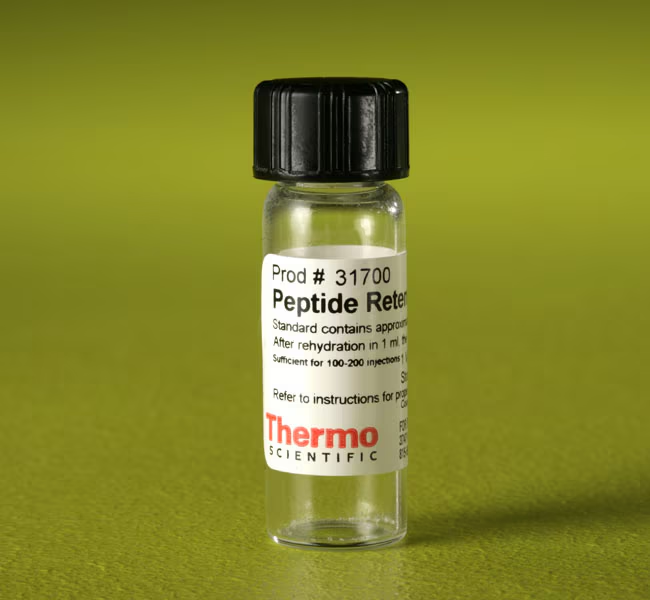
Thermo Scientific Pierce Peptide Retention Standard is a mixture of five c-terminal amide decapeptides that provide reference elution profiles in reverse-phase HPLC.
Features of Peptide Retention Standard:
• Determine the relative order of peptide elution from a complex mixture
• Efficiently predict peptide elution profiles to simplify identification and save purification time
• Identify peptides of known amino acid composition on reverse phase HPLC columns
• Monitor column performance—efficiency, selectivity and resolution during column aging
• Evaluate reverse-phase supports of varying n-alkyl chain lengths and ligand densities
• Compare reverse-phase columns from different manufacturers
Peptide Retention Standard allows accurate prediction of elution time for peptides of known amino acid composition up to 20 residues in length. The reference standard helps to predict the relative order of peptide elution within a complex mixture, simplifying identification of specified peptides and saving time in peptide purification. By testing the standard frequently throughout the lifetime of a column, it is possible to monitor performance characteristics such as efficiency, selectivity, and resolution during column aging. The standard can also be used to evaluate different reverse phase supports of varying n-alkyl chain lengths and ligand density, as well as columns from different manufacturers.
The Peptide Retention Standard consists of five C-terminal amide decapeptides, denoted S1 to S5, having the generic formula Ac-Arg-Gly-X-X-Gly-Leu-Gly-Leu-Gly-Lys-Amide. Four of these peptides are Na-acetylated with the sequence variation as follows: Gly3-Gly4, Ala3-Gly4, Val3-Gly4 and Val3-Val4. The fifth peptide, Ala3-Gly4, contains a free Na-amino group. This mixture will provide 100-200 injections (approximately 0.1 mg of each peptide) at 0.1 AUFS at 210nm. The Peptide Retention Standard is supplied as a dry film in a sealed vial.
A simple, quantitative method for predicting peptide retention times was developed by Guo, et al. (1985, 1986). Retention times are predicted by totaling the values that represent the contribution in minutes of each amino acid residue and the peptide terminal groups.
Retention time is dependent upon the molecular weight of the peptide. The effect on retention is relatively unimportant with a small peptide, but it increases with the size of the molecule. The accuracy of predicting peptide retention time significantly decreases beyond 20 residues. To ensure accuracy, a peptide standard is used to correct for instrument variation, column aging, n-alkyl chain length variation and ligand density.
| Code | Description |
|---|---|
| 31700 | Catalog Number: 31700 |

